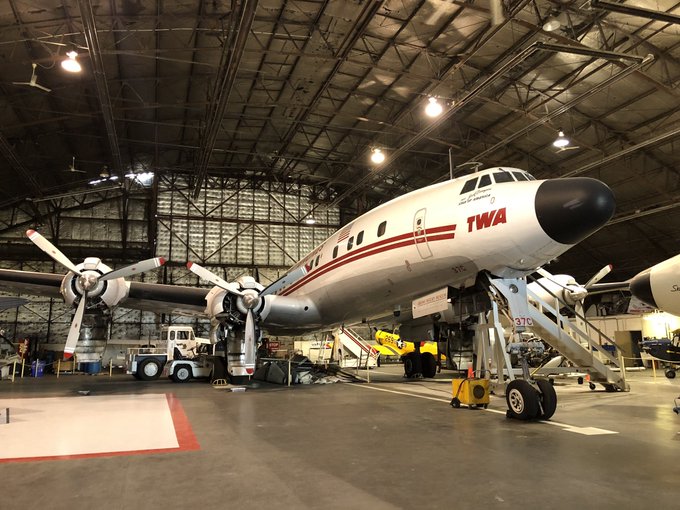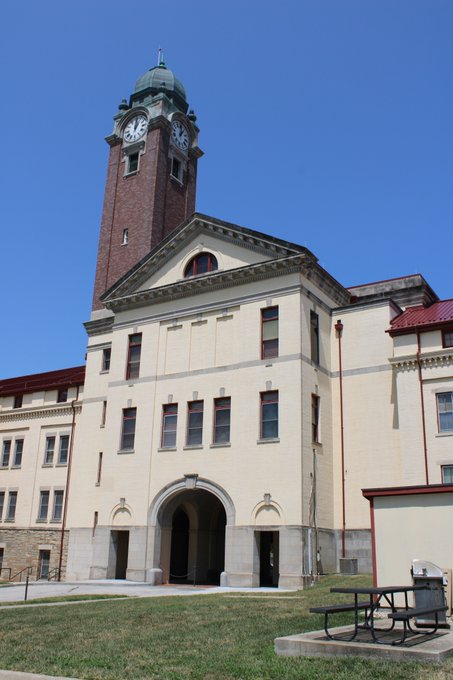December 20, 2022
On to St. Joseph.
Railroad cars beside a grain elevator outside Kansas City, Missouri.

Kansas City has long been a major transportation hub in the center of the country. Before departing it entirely, we paid a visit to the TWA Museum at the airline’s former corporate headquarters at Charles B. Wheeler Airport just outside of downtown.




The propeller of a Ford Trimotor flown by Charles Lindbergh to promote TWA in its early days in Kansas City.

A wicker chair that served as a First Class seat in a TWA Ford Trimotor. This particular chair was sat in by Amelia Earhart, hired to promote the airline to women.

A Lockheed Model 10 Electra, dating from the 1930s, in the working hanger attached to the TWA Museum in Kansas City. The plane is airworthy. The second window from the right, above the plane, was Howard Hughes’ office when he ran TWA.



The eccentric oil and Hollywood film tycoon Howard Hughes, himself a record-setting aviator, bought a controlling stake in TWA after World War II and transformed it into an international airline. He is portrayed here (bottom right) in a promotional poster.

As I mentioned, the TWA museum is located in the airline’s former corporate HQ. The room here, just off the hangar, was used to train new TWA pilots.

This machine on the wall allowed TWA instructors to give pilots and flight attendants pop quizzes on safety and other procedures. If you press the correct answer, the green light turns on; the wrong one, the red one does.

The rooms contain several simulators and mock-ups once used to train TWA pilots and flight attendants.

This isn’t the interior of a real airliner. It’s the mock-up used by TWA to train flight attendants in both servicing passengers and responding to emergencies.


The recreation of a first class lounge at the TWA Museum in Kansas City. The museum has plans – postponed by COVID – to offer “Flight to Nowhere” evenings that include a reception here followed by a dinner served onboard the cabin mock-up by former flight attendants.

On the other side of the airport runway in Kansas City stands another hangar, home to a second museum, the Airline History Museum.

Check out the TWA Super Constellation – the majestic pinnacle of propeller-driven airliners just before the arrival of the jet age.

But wait, isn’t this post about the Oregon Trail? In the 1840s, there was no fly-over country. To remind us of that, our next visit was to the Frontier Army Museum at Fort Leavenworth, Kansas. Though the museum is open to the public, it took a bit of time to apply for a security pass to get onto what still is a very active military post.

The fort was originally founded in 1827 by Colonel Henry Leavenworth, who was ordered to secure a base on the western bank of the Missouri River to protect the Santa Fe Trail into Mexico.

Throughout the 19th Century, Fort Leavenworth served as the critical logistics base for western expansion, whether into Mexico or across to Oregon, or to support the military actions against the Indian tribes in-between.

During the war with Mexico, Colonel Stephen Kearny advanced from Fort Leavenworth to capture what became the American Southwest before peace could be declared.

Its troops provided security and supplies for emigrants along the Oregon Trail, and later for homesteaders settling the prairie.

Later, in the 20th Century, Fort Leavenworth helped support the punitive expeditions into Mexico in search of Pancho Villa.


A heavy cloak to protect US soldiers against severe winter weather in remote posts on the western frontier.

A US Army hospital wagon on display at the Frontier Army Museum on Fort Leavenworth, Kansas.

Many of the US troops on the western frontier were African-Americans, who the Indians called “buffalo soldiers” (because of their short curly black hair). This monument at Fort Leavenworth to the Buffalo Soldiers was unveiled by Colin Powell in 1992.

In the 20th Century, Fort Leavenworth became the primary US Army school for developing doctrine and training for future wars. Senior leaders like Eisenhower, Patton, and Hap Arnold studied here.

Fort Leavenworth today remains the “intellectual center of the Army”, and many of the educational buildings give it as resemblance to a college campus.

Fort Leavenworth has also long been home to the United States Disciplinary Barracks, the prison for those convicted of crimes while serving in the US military. Needless to say, we were not allowed anywhere near it.

Just west of Fort Leavenworth, on our way to Atchison, we passed the imposing entrance to the massive federal penitentiary there (not to be confused with the military prison). It would have made a great photo, but all the prominent “no trespassing” signs made me think again.

So I made a special exception and grabbed these last two photos off the internet, just to give you an idea.
A bit further up the Missouri River is Atchison, Kansas, the eastern starting point of the Atchison, Topeka & Santa Fe Railroad.

Old steam locomotive in Atchison, Kansas.

The childhood home of aviatrix Amelia Earhart, overlooking the Missouri River in Atchison, Kansas. She lived here with with grandmother and younger sister until the age of 12. Her bedroom was the big window directly over the main doorway.

View of the Missouri River from Amelia Earhart’s childhood home in Atchison, Kansas.

On the campus of Missouri Western State University, just outside his hometown of St. Joseph, Missouri, we paid a visit to the Walter Cronkite Memorial.

The small museum displays videos of the most important news events Cronkite covered, including the Cuban Missile Crisis, Kennedy Assassinations, Civil Rights Movement, Vietnam War, Moon Landing, Nixon’s Visit to China, Watergate, and Iran Hostage Crisis.




It also documents Cronkite’s experiences as a journalist during World War II, including flying in a B-17 bombing raid over Germany and landing in a glider into Holland.



The home of Joseph Robidoux, an important French fur trader along the Missouri River, and for which St. Joseph is named. We’ll encounter his trading post further along the Oregon Trail.

I promised I’d tell how Jesse James was killed when we reached St. Joseph. This is the house where he met his end in 1882, at the age of 34.

A member of his gang, Robert Ford, shot and killed Jesse while he was standing on a chair to fix a picture frame, in order to claim a reward. The bullet hole can be seen in the wall.

Next to the Jesse James house stands the Patee House, a 140-room hotel built in 1858. That was huge for its time, and gives some idea was an important departure point St. Joseph was for the Western frontier.

A standard room at the deluxe Patee Hotel in St. Joseph, Missouri, for those heading west on the trails.

The main office of the Pony Express, inside the Patee Hotel, in St. Joseph, Missouri. Send your message here and it will arrive in San Francisco in just 10 days!

The Central Overland Stage Coach – the parent company of the Pony Express – displayed in the lobby of Patee House.

Mock-up of a general store for purchasing supplies for the Oregon Trail, St. Joseph, Missouri.

All ready to set out on the Oregon Trail from St. Joseph, Missouri.

Wait, who brought the electric toaster?

The original Pony Express stables, now a museum, in St. Joseph, Missouri.

The Pony Express delivered the mail from St. Joseph (its eastern terminus) to California and back by a relay system of horseback riders.

It followed much of the original route of the Oregon Trail, and we will pass numerous Pony Express relay stations over the next few days.

The Pony Express began service on April 3, 1860. It was not a business success, and ceased operations just over a year later on October 26, 1861, after it was superseded by a telegraph line.

However short-lived, the Pony Express became embedded in the popular consciousness of the American West (in large part due to “Buffalo Bill” Cody, who we’ll meet down the road).

That evening, outside of St. Joseph, I took my son to a firearms shooting range for the first time. You never know what skills you’ll need on the Oregon Trail.

The journey continues here, in Part 3: Across the Plains to Fort Kearney.
[…] The journey continues here, in Part 2: On to St. Joseph. […]